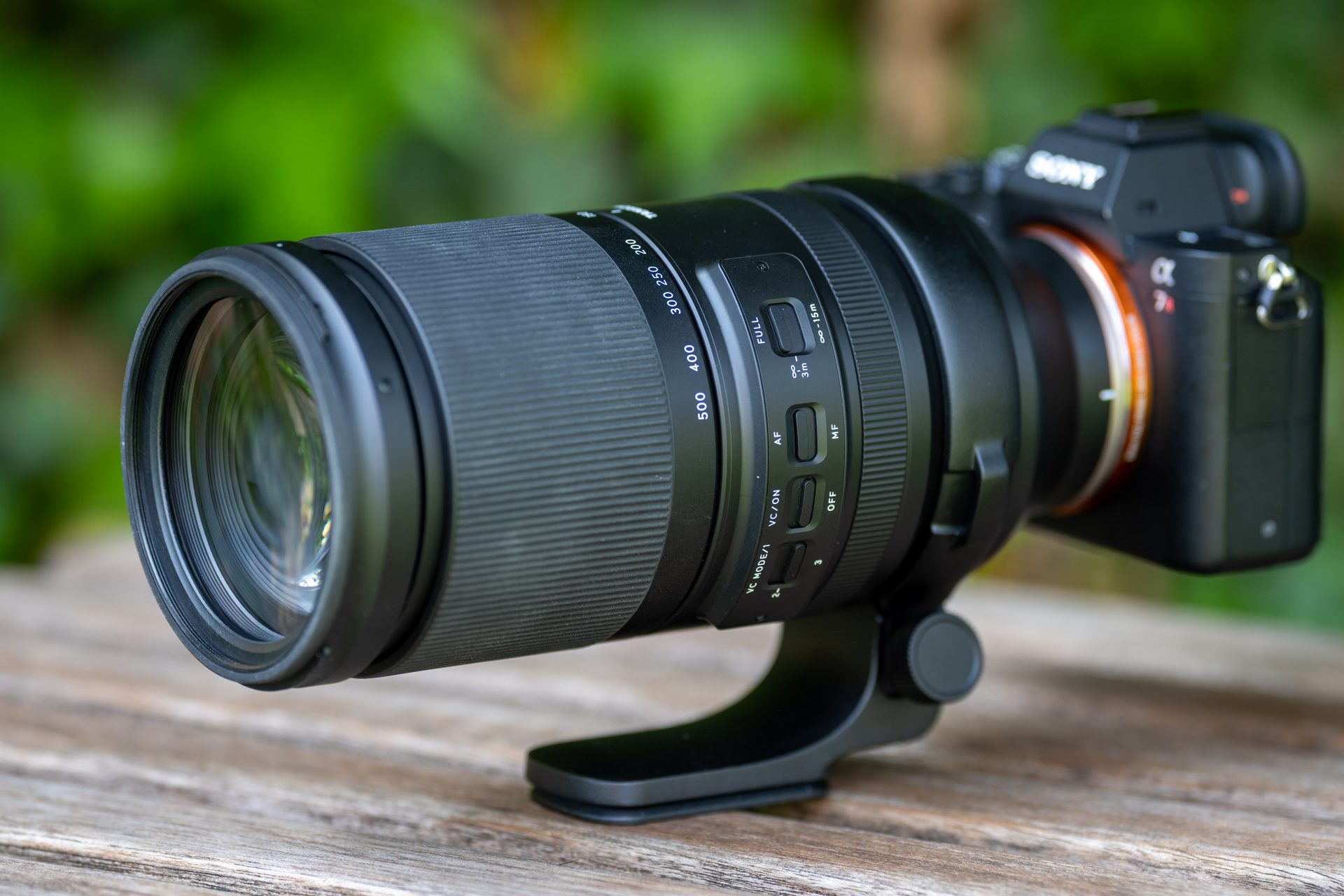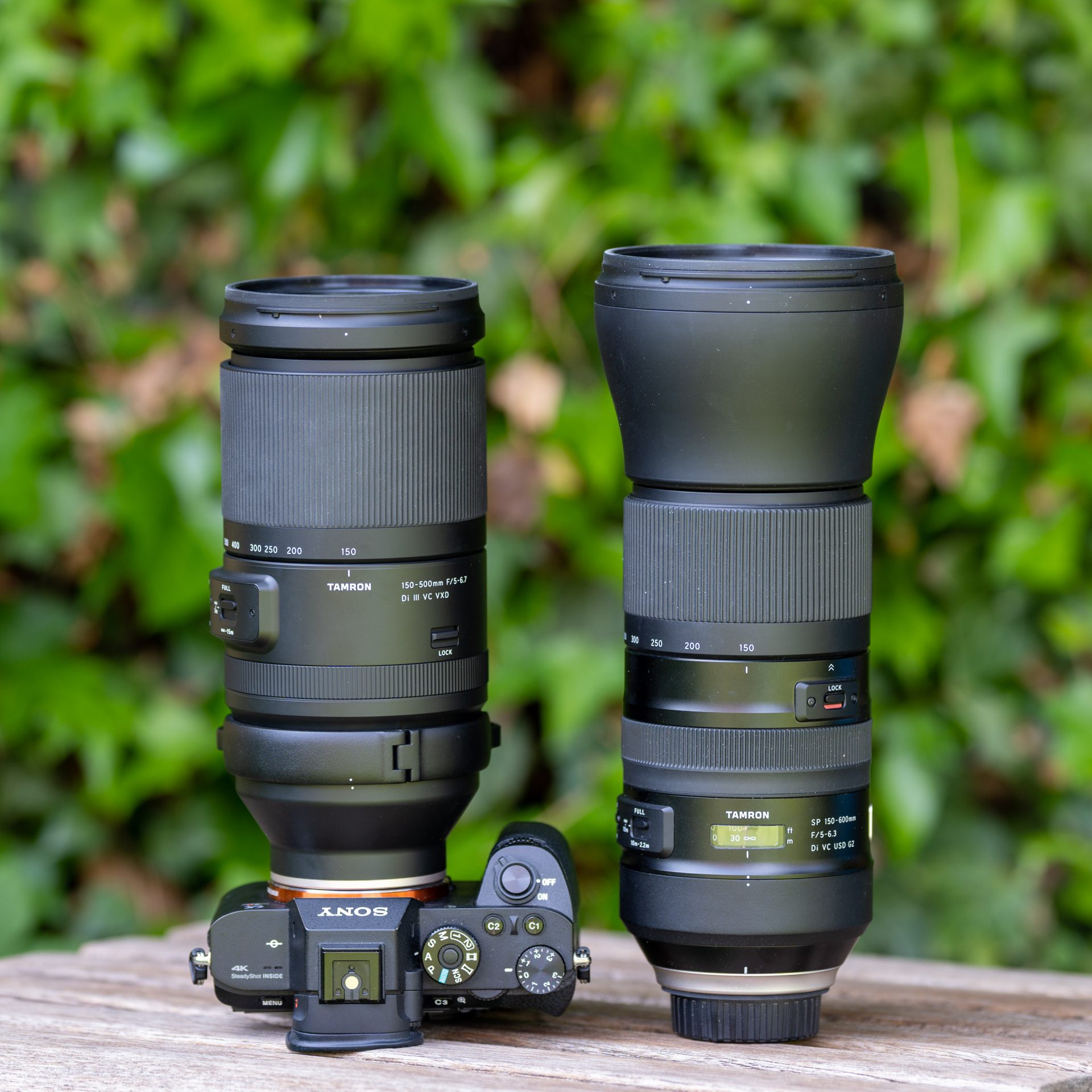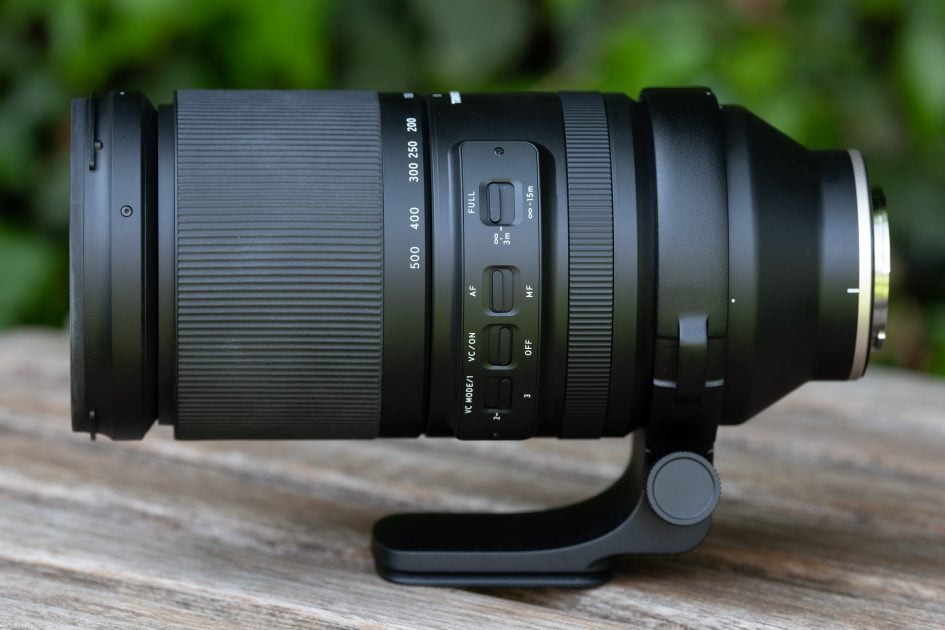Tamron 150-500mm f5-6.7 Di III VC review
-
-
Written by Thomas
Intro
The Tamron 150-500mm f5-6.7 Di III VC (model A057) is a long telephoto zoom designed for full-frame mirrorless cameras. Announced in April 2021 for Sony E-mount, it complements Tamron’s 70-300mm f4.5-6.3 Di III RXD or 70-180mm f2.8 Di III VXD for those who need more reach. In October 2022 the lens also becomes available for Fujifilm X-mount cameras (APS-C format sensor) where it offers an angle-of-view equivalent to 225-750mm focal length.
Unlike its shorter siblings Tamron’s 150-500mm zoom lens features optical image stabilization (VC) – an essential feature for long telephoto lenses. It also is fully weather-sealed including fluorine coating on the front lens and comes with a removable tripod-collar with Arca-Swiss style tripod interface. The lens is pretty compact at 21cm length (without lens hood) but – like many other long telephoto designs – extends when zoomed in. Tamron has equipped the lens with “flex zoom lock”, a pretty nifty feature which let’s you lock the zoom at any position by simply pushing the zoom ring forward. And for those who like to shoot small objects the 150-500mm f5-6.7 Di III VC allows for a maximum magnification of almost 1:3.
The lens is currently listed at around 1200 EUR / 1299 USD / 1100 GBP for Sony E-mount. I assume pricing for the X-mount version will be similar. PS – if you’re interested in Tamron’s other full-frame zoom lenses for E-mount I’ve tested so far check out my in-depth reviews: Tamron 17-28mm f2.8 Di III RXD review / Tamron 28-75mm f2.8 Di III RXD review / Tamron 70-180mm f2.8 Di III VXD.
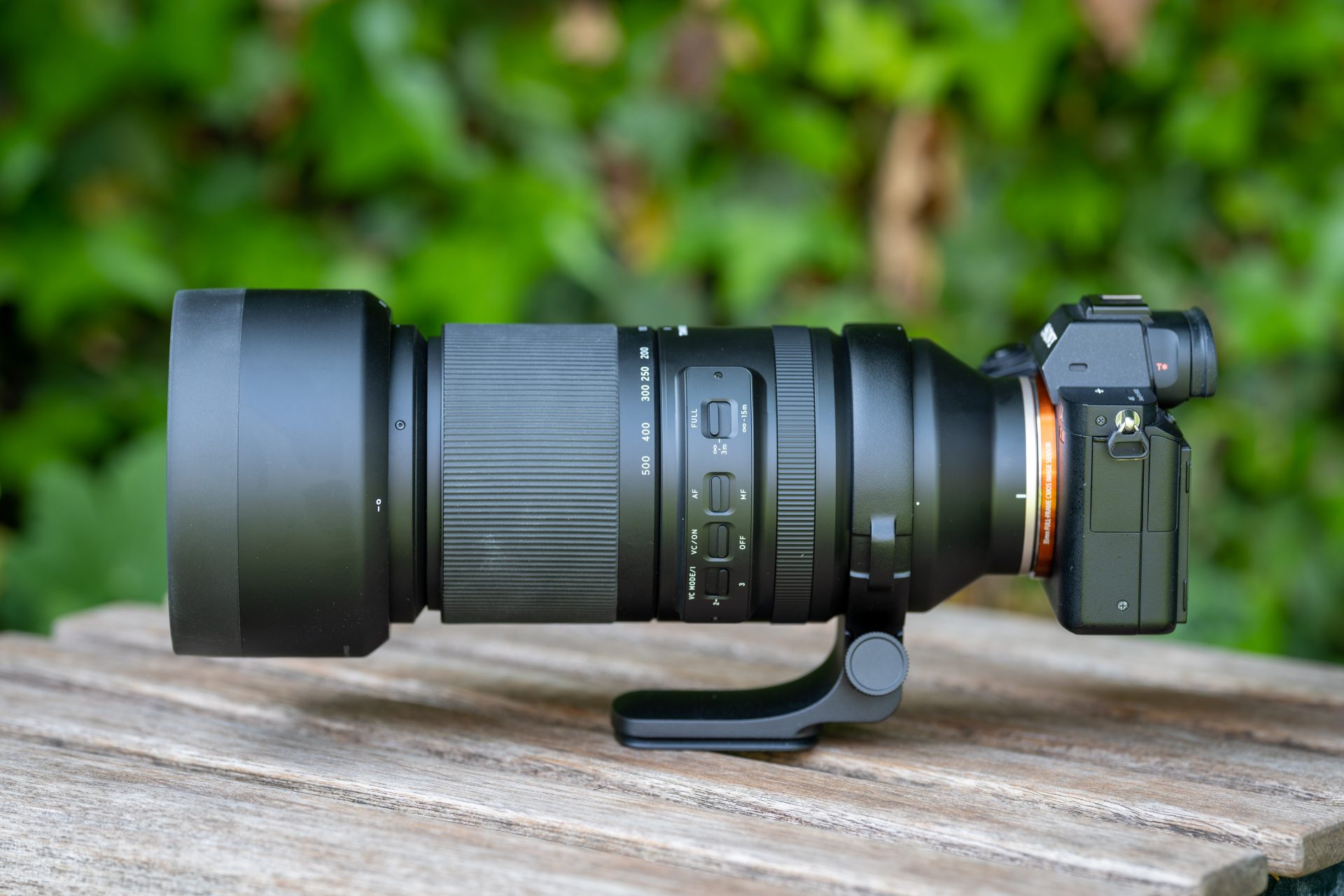
Facts and features
Let’s compare the new Tamron 150-500mm f5-6.7 Di III VC (“Tamron 150-500” for short) to the Sigma 100-400mm f5-6.3 DG DN OS (“Sigma 100-400”), Sony FE 100-400mm f4.5-5.6 GM OSS (“Sony 100-400”), and Sony FE 200-600mm f5.6-6.3 G OSS (“Sony 200-600”). For good measure I’ve also added the Tamron SP AF 150-600mm f5-6.3 Di VC USD G2 (“Tamron 150-600”) to the mix. Although it is a DSLR design from 2016 it was a very good and popular lens then and still can be used via Sigma’s MC-11 Canon EF to Sony E mount converter – which adds 26mm in length, approx. 120g in weight and 250 EUR in costs. I’ve also put in some comparisons with the Fujifilm Fujinon XF 100-400mm f4.5-5.6 R LM OIS WR (“Fuji 100-400”) and XF 150-600mm f5.6-8.0 R LM OIS WR (“Fuji 150-600”). As usual I’ve rated the features with a [+] (or [++]), when it’s better than average or even state of the art, a [0] if it’s standard or just average, and [-] if there’s a disadvantage.
Size (diameter x length): at 93 x 209mm (3.7 x 8.3in.) plus 55mm for the lens hood (113mm diameter) the Tamron 150-500 is quite short for a lens reaching 500mm focal length. The Sigma 100-400 is 86 x 199mm, the Sony 100-400 is 94 x 205mm, the Sony 200-600 is 112 x 318mm, the Fuji 100-400 is 95 x 211mm, the Fuji 150-600 is 99 x 315mm (all five without lens hood), the Tamron 150-600 is 108 x 260mm + 97mm lens hood. All lenses except for the Sony 200-600 and Fuji 150-600 extend when zoomed to their longest focal length: The Tamron 150-500 extends to 283mm which is only a little longer than the Sony 100-400, the Tamron 150-600 goes to 338mm length (without lens hood). [+]
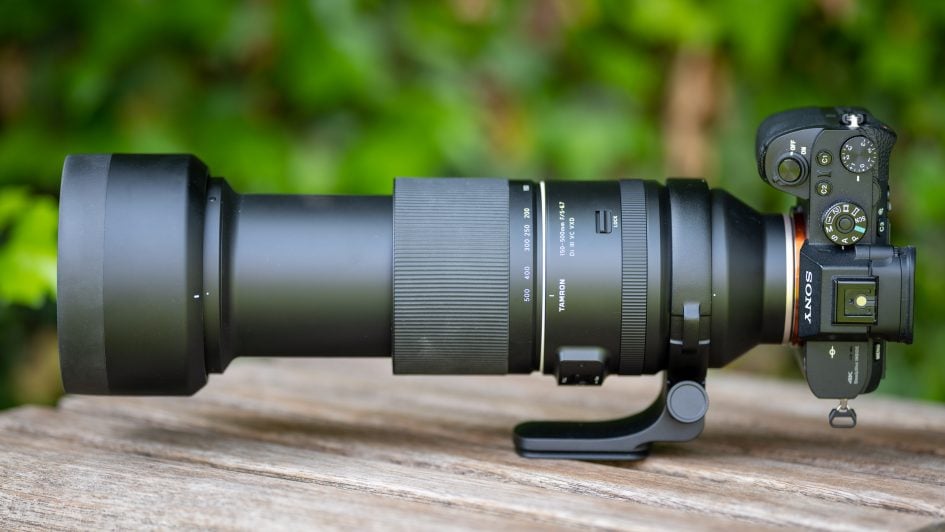
Weight: 1725g (3.8 lb.) plus 95g for the lens hood and another 155g for the tripod collar. The Sigma 100-400 weighs 1140g, the Sony 100-400 is 1395g, the Sony 200-600 is 2115g, the Fuji 100-400 is 1375g, the Fuji 150-600 is 1605g (all five without lens hood or tripod foot), the Tamron 150-600 is 1784g + 108g lens hood + 200g tripod collar. [0]
Optics: The Tamron 150-500mm f5-6.7 Di III VC is a pretty complex design with 25 elements in 16 groups including 6 special dispersion elements and 2 aspherical elements. The other lenses in this comparison are of a similarly complex construction. Both Tamron and both Sony lenses have fluorine coating at the front lens to repel water, dust, and dirt and make cleaning easier plus improved anti-reflective coating using nanotechnology. [+]
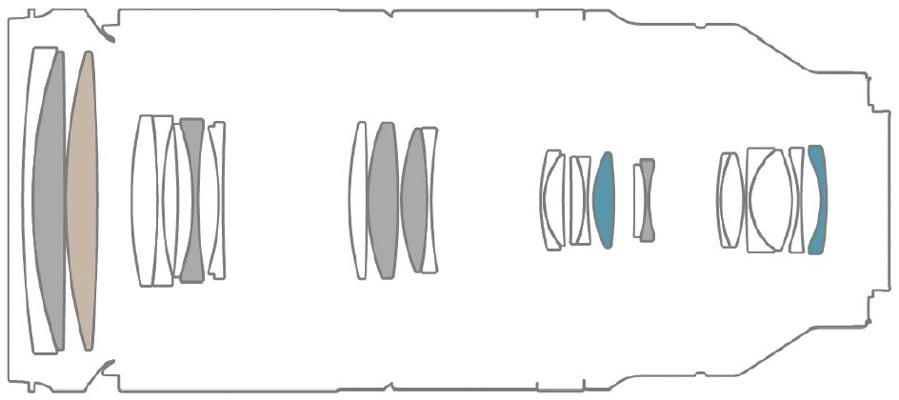
Focal ratio: The Tamron starts with a f5.0 focal ratio at the short end which is par for the course. It’s f5.6 at 250mm, f6.3 at 400mm, f6.7 at 500mm focal length. This is only slightly slower than the Sony 200-600 or Tamron 150-600 at the long end. [0]
Closest focus distance is 0.60m (2.0ft.) with a magnification of 1:3.1 and a working distance of 0.37m (1.2ft.) at 150mm focal length. At 500mm focal length maximum magnification is 1:3.7 which is still quite good and results in a much longer working distance of around 1.5m (4.9ft.). For details see table below. With manual focus I could get even closer and achieve higher magnifications: 1:2.8 at 150mm focal length and 1:3.2 at 500mm focal length. The other lenses in this comparison achieve their maximum magnification at their longest focal length: This is 1:4.1 at 1.3m working distance for the Sigma 100-400, 1:2.9 at 0.7m working distance for the Sony 100-400, 1:5.0 at 2.1m working distance for the Sony 200-600, 1:5.3 at 1.5m working distance for the Fuji 100-400, 1:4.2 at 2.0m working distance for the Fuji 150-600, and 1:3.5 at 1.6m working distance for the Tamron 150-600. The Tamron 150-500 achieves a magnification of 1:10 at its longest focal length at 4.88m (16ft.) distance. [+]

Use with teleconverters: No, the Tamron 150-500 cannot be used with Sony’s teleconverters. Same for the Sigma 100-400. Both Sony zoom lenses can be used with Sony’s 1.4x and 2x teleconverters as can the Fujifilm lenses with the respective teleconverters from Fujifilm. The Tamron 150-600 can be used with Tamron’s own 1.4x and 2x teleconverters. Whether this combo works via Sigma’s MC-11 mount-converter on a Sony E-mount body I can’t say. [0]
Filter-thread: 82mm, just like the Fuji 150-600. The Sigma 100-400 takes 67mm filters, the Sony 100-400 and Fuji 100-400 have a 77mm thread, and both the Sony 200-600 and Tamron 150-600 need huge 95mm filters. [0]
Image stabilization: All lenses in this comparison have optical image stabilization built in. This works together with the sensor-based image stabilization of the Sony Alpha or Fujifilm X-mount mirrorless cameras – except for the Tamron 150-600. The Tamron 150-500 offers three modes: Mode 1 is standard stabilization, mode 2 is specifically for panning, mode 3 maximizes viewfinder stabilization for easier framing. [+]
Autofocus: All lenses in this comparison offer autofocus with built-in focus drive. Manual-focus override is by simply turning the dedicated focus ring. The focus ring on the Tamron 150-500 has the usual variable gearing of an original mirrorless design which allows for very precise manual focus when turned slowly but cannot be switched to linear gearing. Which makes smooth focus pulling for videographers almost impossible. The Tamron 150-600 has the usual direct coupling and linear gearing of a lens designed for DSLRs and the Sony 200-600 also offers linear response for MF. [+]
All lenses in this comparison except for Fujifilm’s cover full frame sensors or can equally be used on a cropped APS-C camera body. [+]
Price: The Tamron 150-500 currently sells for 1200 EUR (incl. 19% VAT) / 1299 USD / 1100 GBP. The Sigma 100-400 is 980 EUR / 950 USD / 900 GBP, the Sony 100-400 is 2400 EUR / 2400 USD / 2050 GBP, the Sony 200-600 is 1730 EUR / 2000 USD / 1500 GBP, the Fuji 100-400 is 1700 EUR / 1900 USD / 1545 GBP, the Fuji 150-600 is 2200 EUR / 2000 USD / 1900 GBP, the Tamron 150-600 currently sells for 1000 EUR / 1200 USD / 850 GBP. [0]
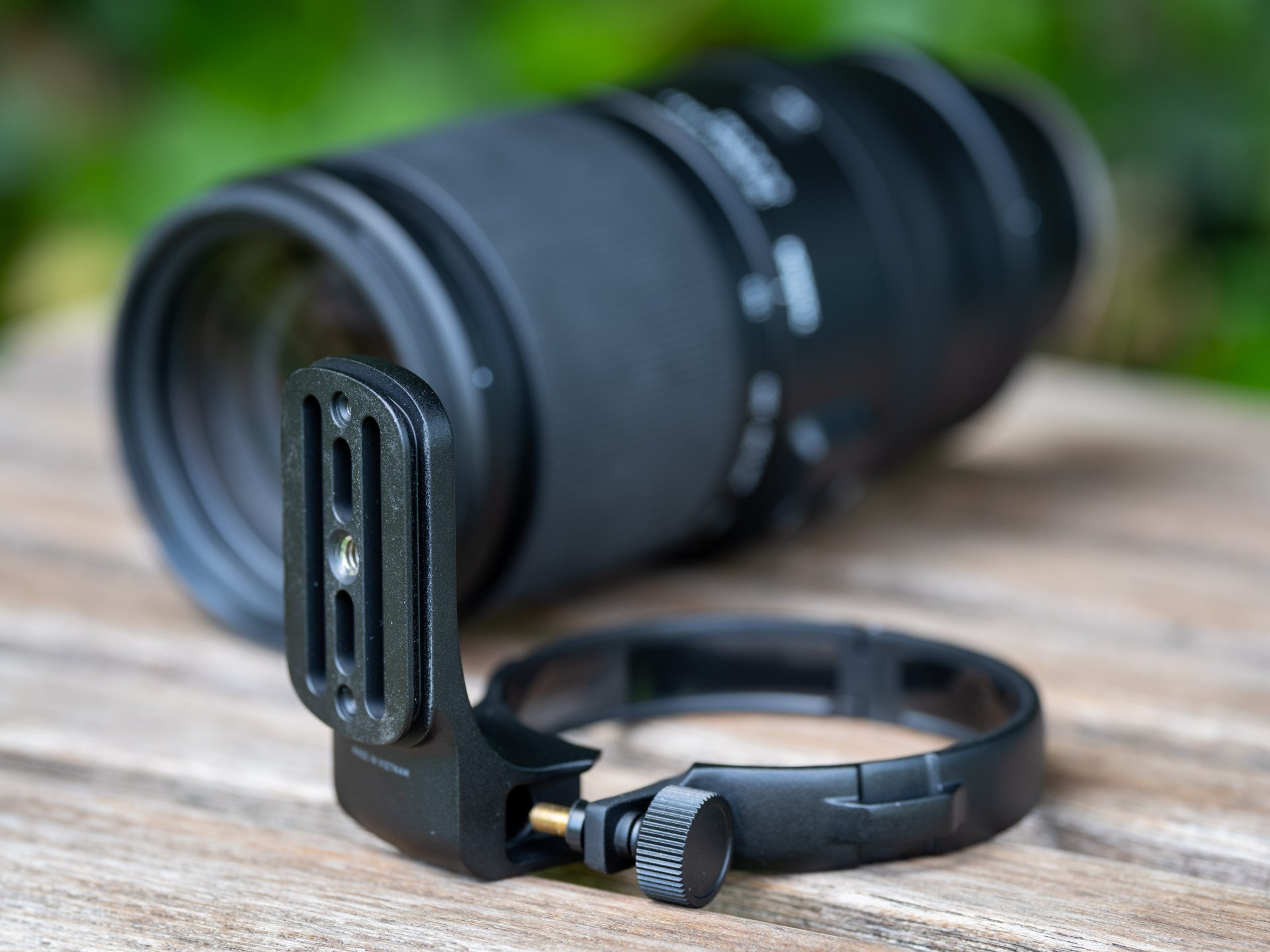
The Tamron 150-500 comes without a pouch but the Arca-Swiss compatible tripod mount (with strap attachment holes) and the reversible lens hood is included. Its lens hood has a rubberized front end to prevent dinks and scratches when the lens is set down on it. And the tripod collar can be completely removed from the lens. The Sigma 100-400 also comes without pouch and the tripod mount is an optional extra. Both Sonys and the Tamron 150-600 come with a pouch and have the detachable tripod mount included but the Sonys don’t have an Arca-Swiss interface. The lens hood of the Sony 100-400, Fuji 100-400, and Fuji 150-600 has a sliding window through which a polarizing or variable ND filter can be adjusted and it also has a lock to prevent it from accidentally falling off. [0]
Aperture ring and other control elements: None of the lenses in this comparison have an aperture ring. But all have a focus limiter: The Tamron 150-500 offering three positions: full/inf-3m/inf-15m. You can also select different modes for the optical image stabilization on all five lenses. Both Tamron lenses offer the nice Flex Zoom Lock feature in addition to a standard zoom lock at 150mm: simply push the zoom ring forward to lock the zoom at any position (see below). [+]
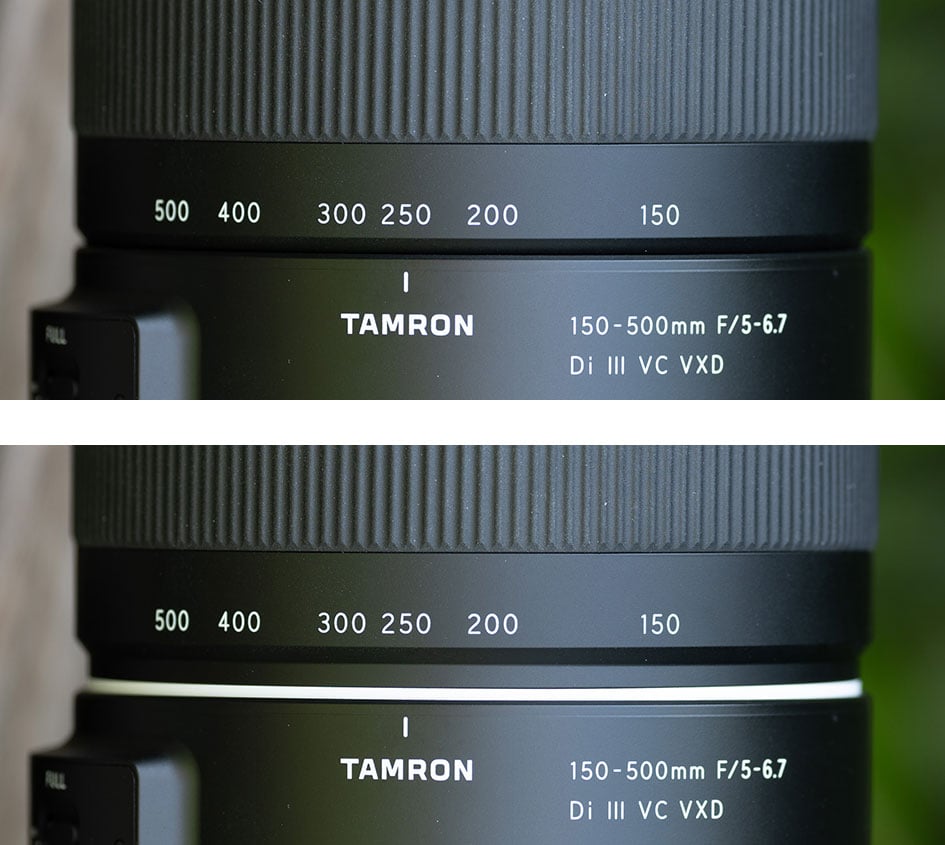
Sealing: All lenses have a rubber grommet at the lens-mount. Plus further special weather-sealing throughout the construction except for the Sigma 100-400. Both Tamrons also have a rubberized front-end that acts as a seal when the front lens-cap is attached. [+]
At a score of 0[-]/6[0]/8[+] the Tamron 150-500mm f5-6.7 Di III VC looks like a well balanced design with no real downsides. It is certainly not a light lens and the price seems a bit on the high side. But it takes you to 500mm focal length at a size where other lenses only reach 400mm, it has the tripod mount included (which is an essential accessory for any less longer than 300mm) with Arca-Swiss style interface, a flexible zoom lock feature and is thoroughly sealed against the elements. Plus it can reach magnifications of around 1:3 at very usable working distances.
Two long telephoto zoom lenses
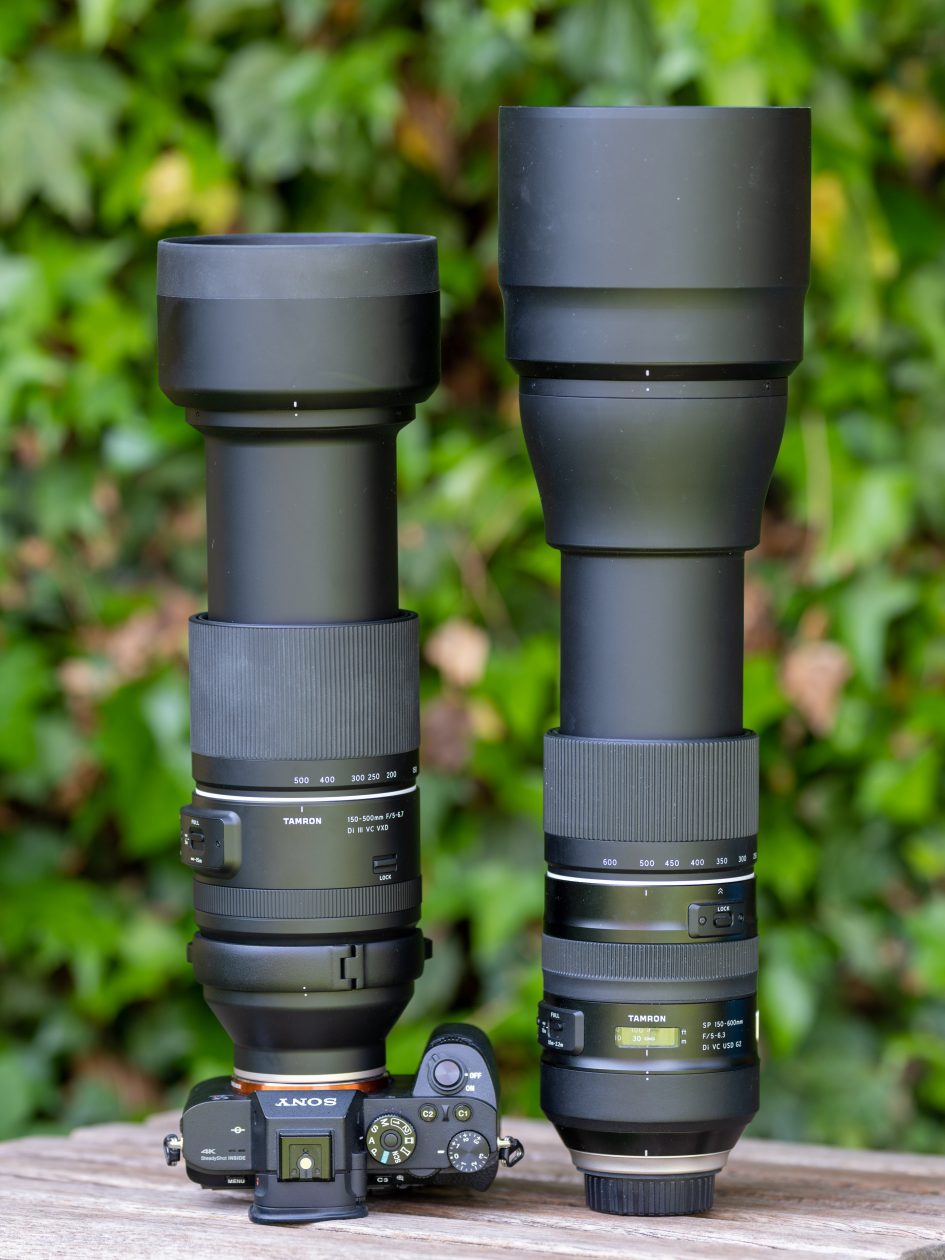
Above: Tamron 150-500mm f5-6.7 Di III VC (left), Tamron SP AF 150-600mm f5-6.3 Di VC USD G2 (right, needs mount converter)
Coverage
With its 3.3x zoom-range the Tamron 150-500 has a bit more range than the 3x of the Sony 200-600 but less than the 4x zoom-range of 100-400mm lenses or the Tamron and Fujifilm 150-600. At the short end the Tamron 150-500mm has an angle of view of 16 degrees, compared to the 24 degrees of the zooms starting at 100mm and the 12.5 degrees of the Sony 200-600mm. At the long end the Tamron 150-500 offers 25% more reach/magnification than the 100-400mm zooms but the Tamron and Fuji 150-600 as well as the Sony 200-600 reach even 20% further.
Here is the angle of view that the Tamron 150-500mm f5-6.7 Di III VC covers compared to the angle of view at 100mm, 200mm, 400mm or 600mm:
Above: Tamron 150-500mm f5-6.7 Di III VC coverage on a full-frame camera at 150mm (left) and 500mm (right), Distortion Compensation AUTO
Above: Angle of view of 100mm (left) and 400mm (right) on a full-frame camera
Above: Angle of view of 200mm (left) and 600mm (right) on a full-frame camera
The difference between the Tamron 150-500mm f5-6.7 Di III VC starting at 150mm versus a lens starting at 100mm is clearly visible and might be a decisive factor for choosing a zoom lens. Not always can you step back enough to get the wider view of 100mm focal length. And the other thing of note: The benefit of reaching 600mm with the Sony 200-600 or Tamron 150-600 is perhaps not as big as expected. If the image at 500mm is sharp enough, cropping a 42MP shot at 500mm to match the angle-of-view of at 600mm still nets you around 29MP. This might well be enough for the intended purpose.
Using the Tamron 150-500mm f5-6.7 Di III VC on a Fujifilm X-mount camera (or any APS-C sized sensor) crops the image by 1.5x. This leeds to an angle-of-view which is even narrower than 200mm (on full-frame sensor) at the wide end and results in 25% more reach/magnification at the long end over 600mm on a full-frame sensor.
Focus and zoom
Focus accuracy and repeatability is critical to consistently produce sharp shots. Repeatability (the accuracy of focus on the same subject after repeated focus-acquisition) of the Tamron 150-500mm f5-6.7 Di III VC is very good (measured 99.1% in Reikan FoCal) with no outliers over a series of 40 shots. There is almost no focus variation whether the lens focuses from a closer distance or from infinity but I detected a bit of hunting. At 200mm focal length the lens focuses in around 0.7 sec from infinity to 2.17 m (1:10 magnification).
The zoom ring turns through 75 degrees the way Sony users are used to and has a 53mm wide rubber surface with a good grip. It turns with quite some resistance and can not be operated with one finger. The lens still shows zoom creep if you don’t lock the lens with the switch or by pushing the zoom ring forward. The focus ring is only 11mm wide and is located closer to the camera. It also has a rubberized surface, moves smoothly, and can easily be operated even with your pinky. So easy in fact that I often found that I inadvertently moved the focus setting.
AF-operation and image stabilization of the Tamron 150-500 is inaudible if you record video with the built-in microphone. You can hear a very slight whirring noise from the outside, even with VC switched off and no focus operation. Tamron explained this as noise from the VC which keeps the image stabilization centered – as long as the viewfinder or rear LCD show an image.
As you pull focus, you’ll notice some focus breathing: the image becomes a little more magnified at closer focusing distances. When I adjusted the focus from infinity to 2.17m on the Tamron 150-500 at 200mm focal length, I measured a 3% increase in magnification. At 500mm the effect is a bit stronger but still pretty inconspicuous.
I also tested whether Tamron’s newest zoom lens allows you to change the focal length without altering its focus. This characteristic is called parfocal. I focused the lens at 500mm and then slowly zoomed back checking focus on the way. The 150-500mm f5-6.7 Di III VC is almost perfectly parfocal with only a slight deviation from perfect focus between 400mm and 350mm. But that shouldn’t matter for video recording. Just remember to focus at the longest focal length before zooming.
Image stabilization
To test the effectiveness of the VC image stabilization of the Tamron 150-500mm f5-6.7 Di III VC, I did a series of 120 test-shots hand-held at 500mm focal length and tested with shutter speeds from 1/500 of a second down to 1/30 sec. I used the shots at 1/500 sec with VC=off as reference of how good my hand-holding was at the time of the test and Reikan FoCal did the chore of evaluating the sharpness of all shots.
Here’s the results: With VC switched on in mode 1 the lens produced good results down to 1/125 sec (2 stops). At 1/60 sec (3 stops) half of the shots were too blurred and at 1/30 sec (4 stops) results became very erratic with the occasional hit but many more misses. This is a 2-3 stop advantage from the image stabilization of the lens at 500mm focal length.
But keep in mind that holding/shooting a combo that weighs more than 2.5kg over an extended period of time is always stressful and leads to increased shake. So it’s better to shoot from a tripod, monopod or any support you can get for the lens when using focal lengths beyond 200mm.
Next check out my quality results!
Check prices on the Tamron 150-500mm f/5-6.7 Di III VXD at B&H, Adorama, WEX UK or Calumet.de. Alternatively get yourself a copy of my In Camera book or treat me to a coffee! Thanks!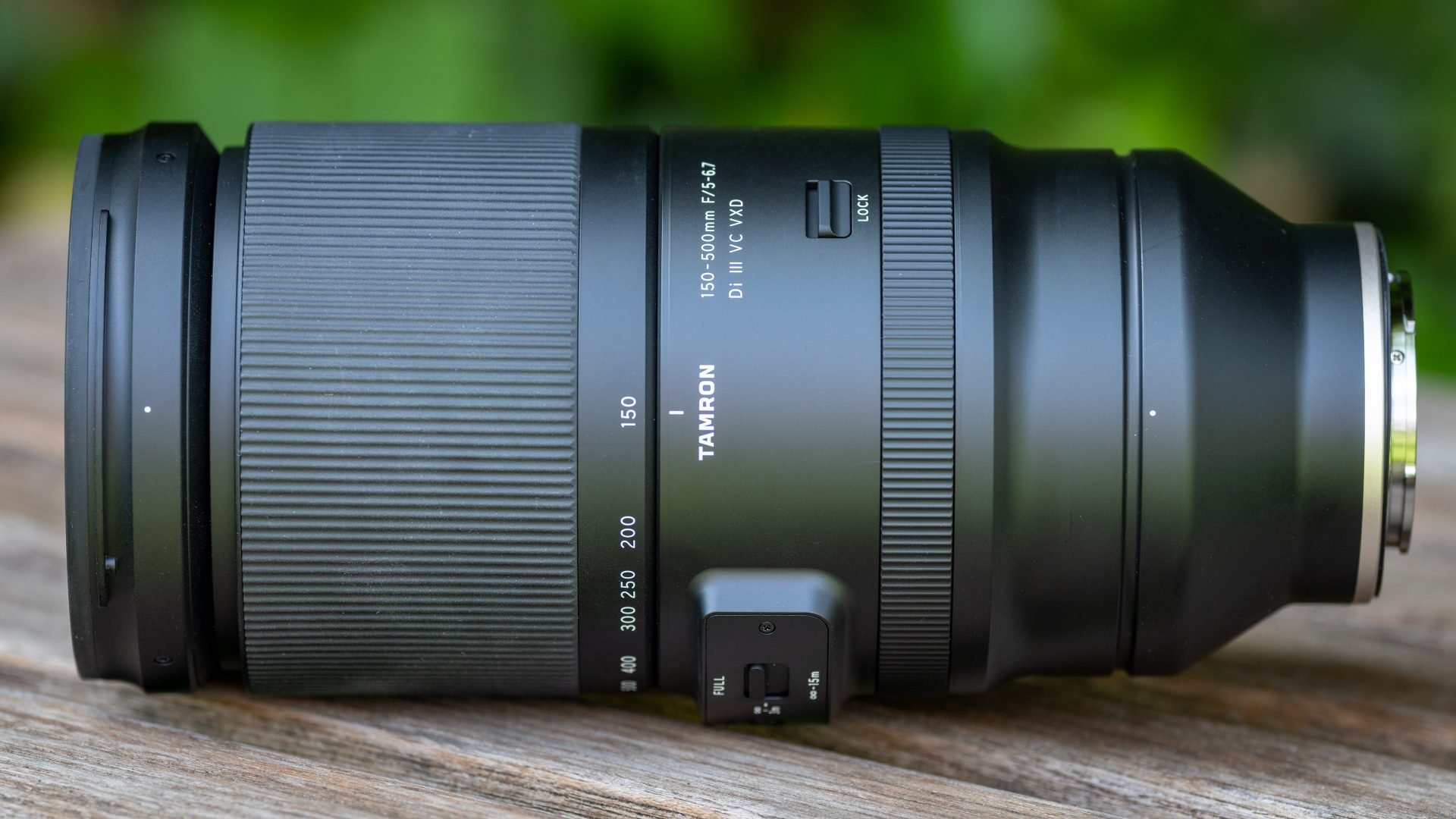
 Tamron has added an interesting alternative for Sony Alpha mirrorless and Fujifilm X-mount camera owners looking for a super-telephoto zoom: Their 150-500mm f5-6.7 Di III VC is pretty compact and much cheaper than Sony's and Fujifilm's own 100-400mm and 150/200-600mm lenses. And Tamron didn't skimp on features or image quality. There're only two thing to be aware of: The lens cannot be used with teleconverters and veiling glare from strong contra-light can reduce contrast considerably. But other than that Tamron has designed a compelling super-telephoto zoom which clearly earns a Recommended!
Tamron has added an interesting alternative for Sony Alpha mirrorless and Fujifilm X-mount camera owners looking for a super-telephoto zoom: Their 150-500mm f5-6.7 Di III VC is pretty compact and much cheaper than Sony's and Fujifilm's own 100-400mm and 150/200-600mm lenses. And Tamron didn't skimp on features or image quality. There're only two thing to be aware of: The lens cannot be used with teleconverters and veiling glare from strong contra-light can reduce contrast considerably. But other than that Tamron has designed a compelling super-telephoto zoom which clearly earns a Recommended!